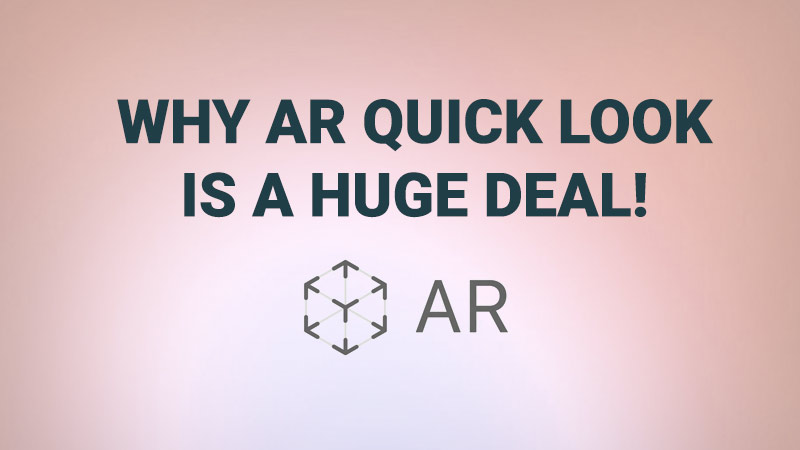Apple AR Quick Look features is a very important feature that helps bring the web into our world by making digital content that we browse through almost tangible and viewable in our real world.
Even at its current introductory stage, the AR Quick Look feature will revolutionize the way we consume some content on the web and sharing it across different messaging and social media application. The usdz file was meant to be portable for easy sharing, accessible for creators and those who consume their content.
I was able to create my own quick 3D text using a 3D design tool and quickly export it to a usdz file and from that point on, sharing my content was just a matter of a minute to implement (you can check out the link above to see in action).
Apple made sure this standardize this new usdz file format by first making sure it is supported by many of its integrated apps like Messages, Safari, Mail, and others. Apple also collaborated with 3D content creation platform developers like Adobe, for example, to make sure that this new file format will be supported by those tools. Adobe has developed an AR authoring tool called “Project Aero”, that allows creators to design great content that can be consumed in augmented reality and support open standards like usdz and glTF among others. There are many more companies who will facilitate an export to usdz feature that can be consumed by apps that support it.
The list of use cases is long, including a life-size preview of products on eCommerce stores like furniture, fan-based virtual content you can touch and feel (haptic), AR advertising, immersive greeting cards, short stories told in both textually and augmentedly right beside each other, enhanced product reviews and product teardowns (e.g. iFixIt) will never be the same again, Snapchat Lens-like easily accessible via a browser with a single click, bringing character static character flat on page into the real world with animation and even sound. The list goes on and on, and as I said, once this becomes widespread, our browsing experience will change forever.
Now, when this technology progresses, we might be able to see some added layer of interaction, like having JigSpace like shareable jigs available on the web in a single click. That content can easily become mega-viral and appear on many living rooms throughout the world. I remember a friend on Twitter said that he used the ARCritic.com text that I made into usdz to spawn it into his own living room. It was an amazing feeling. It’s like I’ve created something physical and I was able to let people use it in their homes through the web. It will be like the YouTube of AR, but instead of watching things on a web page, you view them in the real world environment. Of course, there should be a platform that needs to organize that shareable content, but that platform can be in AR/MR as well, making the discovery experience even more immersive and engaging.
We are slowly saying goodbye to the webpage as we know it and move towards a world where the browser is all around us, circulating us in every angle, it consumes the space around us and the canvas is no longer restricted to a 2D plane, but to the entire world around us.
The usdz will still be the container in which we share content, whether it will be through a standard webpage or a mixed reality application. As for now, we are watching that revolution taking place in front of our eyes. Experiencing it myself for the first time, I can fully comprehend its huge potential and see how it can shape the way we consume content online and I am so fascinated with what I see.
Let’s look a bit forward, what about streaming usdz file content. In fact, based on the usdz format specification on pixar.com, this can be achieved. Imagine for a second that you bought a new product, let’s say a new smartphone and you want to share it live with a friend. Instead of sharing it as an image or video, you can let an app scan the object, create a 3D object out of it with the texture and all, and then that object can be teleported in real-time streamed to your friend that is in another country, so he or she can see the object being “teleported” into their world – Teleportation one-on-one baby!
There are countless opportunities here and all that thanks to that robust and portable 3D content sharing that this file format facilitates. Having it as an open standard means that it will be adopted by many apps, services, and software. Making creation and sharing of content accessible to many people, not just tech-savvy people. The apps, software or services will facilitate that wrapping and delivery of the content and the user will just need to enjoy creating and sharing in a seamless way that isn’t different than sharing an image or a video.
AR Quick Look is a fantastic feature that its roots are embedded deep into iOS 12 DNA and many integrated apps. Seeing Shopify bringing Apple’s AR tech to their platform to help merchants promote products better is just one of the first steps that signal a revolution in the way we consume augmented reality with our mobile devices.
I can’t stop toying around with it myself, so expect some neat little surprises every now and then embedded in my articles. AR never looked so promising, inspiring and accessible – the future is bright, don’t forget to check out AR Quick Look yourself if you have an ARKit-enabled device running iOS 12.0. We only touch the surface of what this technology can sprout. In future articles will take an even deeper dive into this technology, including talking about more technical aspects (still reading a lot about it, will share more information soon).

